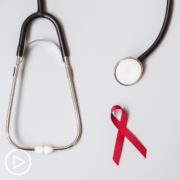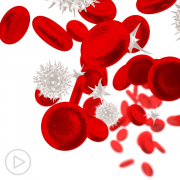What’s the Latest in Emerging Myeloma Research?
What’s the Latest in Emerging Myeloma Research? from Patient Empowerment Network on Vimeo.
Myeloma expert Dr. Benjamin Derman shares research updates from the 2022 American Society of Hematology (ASH) annual meeting, including information about newly approved CAR T-cell therapies and a bispecific antibody therapy, as well as research on the new target, GPRC5D (G protein-coupled receptor 5D).
Dr. Benjamin Derman is a hematologist and oncologist specializing in multiple myeloma at the University of Chicago Medicine Comprehensive Cancer Center. Learn more about Dr. Derman.
See More from Engaging in Myeloma Treatment Decisions
Related Resources:

|

|

|
Transcript:
Katherine:
Joining me is Dr. Benjamin Derman. Dr. Derman, welcome. Would you please introduce yourself?
Dr. Derman:
Yeah. Thanks so much for having me. As you said, my name is Ben Derman. I’m an assistant professor at the University of Chicago. And I specialize in actually, plasma cell disorders, which is mainly multiple myeloma, amyloidosis, Waldenstrom’s. If a plasma cell is the problem, then I address it. So, that’s what I do. And that’s my clinical and research focus as well.
Katherine:
Excellent. Thank you so much for taking the time to join us today. Before we get into our discussion about available myeloma treatments, let’s talk about emerging therapies. And I know there are many.
The American Society of Hematology or ASH annual meeting took place in December. What are some of the highlights from that meeting?
Dr. Derman:
Yeah, ASH is always a very exciting time because it’s when we get to see all the latest and greatest of what’s on the way or what’s already here to stay.
I think the biggest focus in the myeloma field, if I could really pin it down, was more in the later stages of the disease and focusing on treatments in that setting. We already have two FDA-approved chimeric antigen receptors, or CAR T-cell therapies, in Ide-cel (Abecma), and Cilta-cel (Carvykti). Those are the brand names. And then more recently, we just had a bispecific antibody, which is another type of immune therapy that was approved. But there are actually many under investigation.
And so, at this ASH we heard a lot. Not only about the target that’s been most popular in this setting, which is something called BCMA or B-cell maturation antigen.
That’s what the CAR T-cell therapies that I mentioned are going after and the teclistamab (Tecvayli) bispecific antibody that I mentioned.
But there are a lot of other candidate drugs that are also targeting that same molecule. So, we heard a little bit about – more about those. We’ve been hearing about them pretty much at every conference these days.
So, there’s a lot of competition in that space. Which is good for patients because ultimately, what we’re trying to figure out is, is one of these better than the others? Or at least, if we have multiple options, there may be different side effect profiles that we have to think about.
But now as BCMA therapies are getting used more and more, one of the questions is, well, is there any other target that we could go after? And really, the one that was hot at ASH this year was something called GPRC5D, or G-protein coupled receptor 5D. This is expressed pretty strongly in myeloma cells, and not in many other tissues. Maybe the skin, nails, tongue. So, basically, that’s what you want, is you want a target that’s not going to be expressed elsewhere.
So, there were a couple of different types of therapies that were discussed. One was a CAR T-cell therapy going after GPRC5D, and the others were – there were two bispecific antibodies actually targeting the same GPRC5D. And that’s actually already in addition to another GPRC5D-directed bispecific that’s in development.
So, basically, the idea is that if patients may experience progression on one of these BCMA targeting agents, we’re going to have another target to be going after. And I think that part is really, really exciting.
And as far as other highlights, I think the other thing is, how do we reduce the toxicity from these drugs? And exploring avenues in order to be able to decrease sort of the inflammatory effects of these drugs, which are important.










